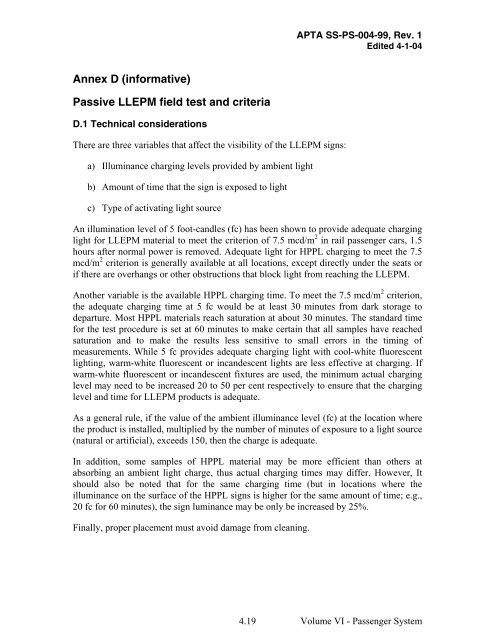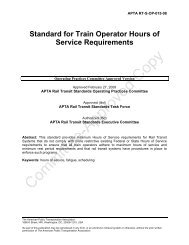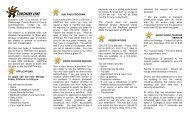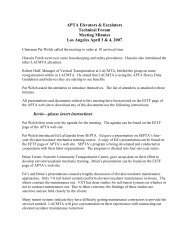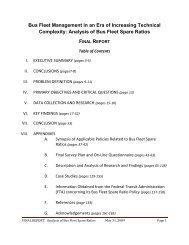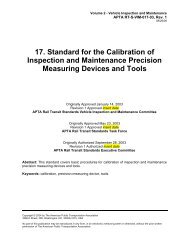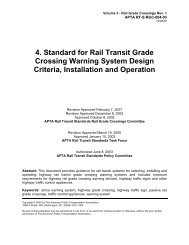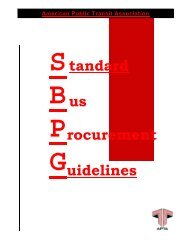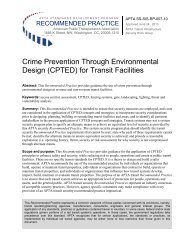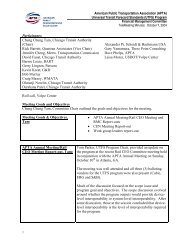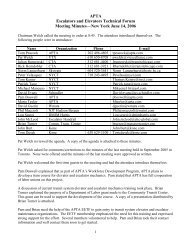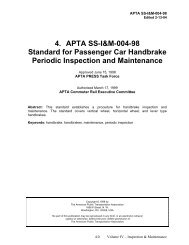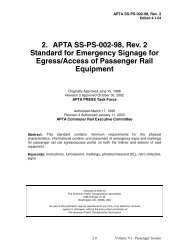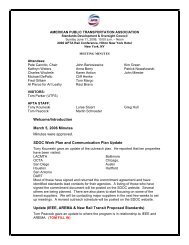4. APTA SS-PS-004-99, Rev. 1 Standard for Low-Location Exit Path ...
4. APTA SS-PS-004-99, Rev. 1 Standard for Low-Location Exit Path ...
4. APTA SS-PS-004-99, Rev. 1 Standard for Low-Location Exit Path ...
Create successful ePaper yourself
Turn your PDF publications into a flip-book with our unique Google optimized e-Paper software.
Annex D (in<strong>for</strong>mative)<br />
Passive LLEPM field test and criteria<br />
D.1 Technical considerations<br />
There are three variables that affect the visibility of the LLEPM signs:<br />
a) Illuminance charging levels provided by ambient light<br />
b) Amount of time that the sign is exposed to light<br />
c) Type of activating light source<br />
<strong>4.</strong>19<br />
<strong>APTA</strong> <strong>SS</strong>-<strong>PS</strong>-<strong>004</strong>-<strong>99</strong>, <strong>Rev</strong>. 1<br />
Edited 4-1-04<br />
An illumination level of 5 foot-candles (fc) has been shown to provide adequate charging<br />
light <strong>for</strong> LLEPM material to meet the criterion of 7.5 mcd/m 2 in rail passenger cars, 1.5<br />
hours after normal power is removed. Adequate light <strong>for</strong> HPPL charging to meet the 7.5<br />
mcd/m 2 criterion is generally available at all locations, except directly under the seats or<br />
if there are overhangs or other obstructions that block light from reaching the LLEPM.<br />
Another variable is the available HPPL charging time. To meet the 7.5 mcd/m 2 criterion,<br />
the adequate charging time at 5 fc would be at least 30 minutes from dark storage to<br />
departure. Most HPPL materials reach saturation at about 30 minutes. The standard time<br />
<strong>for</strong> the test procedure is set at 60 minutes to make certain that all samples have reached<br />
saturation and to make the results less sensitive to small errors in the timing of<br />
measurements. While 5 fc provides adequate charging light with cool-white fluorescent<br />
lighting, warm-white fluorescent or incandescent lights are less effective at charging. If<br />
warm-white fluorescent or incandescent fixtures are used, the minimum actual charging<br />
level may need to be increased 20 to 50 per cent respectively to ensure that the charging<br />
level and time <strong>for</strong> LLEPM products is adequate.<br />
As a general rule, if the value of the ambient illuminance level (fc) at the location where<br />
the product is installed, multiplied by the number of minutes of exposure to a light source<br />
(natural or artificial), exceeds 150, then the charge is adequate.<br />
In addition, some samples of HPPL material may be more efficient than others at<br />
absorbing an ambient light charge, thus actual charging times may differ. However, It<br />
should also be noted that <strong>for</strong> the same charging time (but in locations where the<br />
illuminance on the surface of the HPPL signs is higher <strong>for</strong> the same amount of time; e.g.,<br />
20 fc <strong>for</strong> 60 minutes), the sign luminance may be only be increased by 25%.<br />
Finally, proper placement must avoid damage from cleaning.<br />
Volume VI - Passenger System


